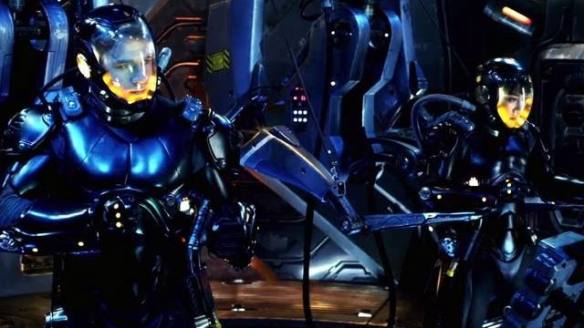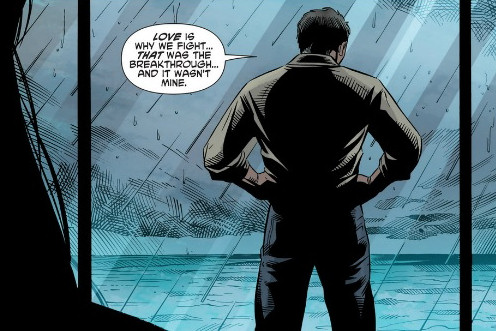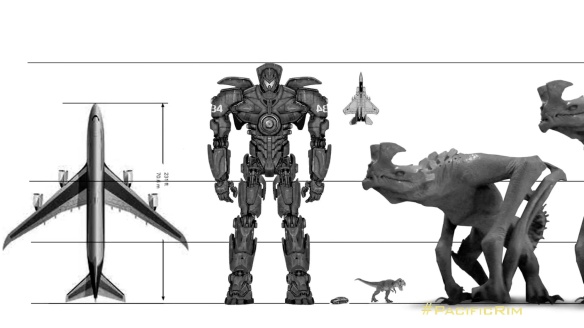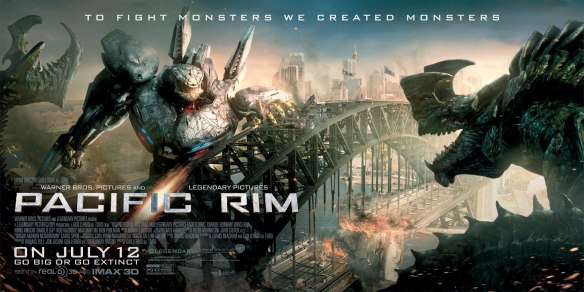This review is also available as an audio review for the Spiritblade Underground Podcast; you can play the video below (it’s just audio however) or listen to the Spiritblade Underground Podcast, episode 277; just click the link, you’ll find my review at 2:43 minutes.
The written review has some extras however that the audio review doesn’t have, like specific links to source material, several illustrations, and two panels from the graphic novel prequel!
Review
Purely based on the title I wouldn’t have picked out this movie from the long list of movies in our local theatre. I mean, to my knowledge Pacific Rim wasn’t any particular idiom or expression, nor a well-known location. But as soon as I saw the movie trailer in the theatre, I think it was during Star Trek Into Darkness or maybe Man of Steel, I immediately knew I just had to see this movie!
Director Guillermo del Toro turns out to have been a fan of Japanese anime from his childhood. In a recent interview with Simon Mayo of Kermode & Mayo’s Film Reviews on BBC Radio 5 Live (you can check out their podcast here or in iTunes), Del Toro recounted his love for the mecha and kaiju creatures that often fill the anime worlds. In very general terms, mecha is the Japanese word for basically any creature or vehicle that is robotic, which in anime are often huge, and by huge I mean really ginormously large. Think Transformers or the gigantic Tripods in War of the Worlds – which by the way, also a GREAT movie, with Tom Cruise. Go find some time and see that one too!
 War of the Worlds – one of the enormous Tripods that would be considered a “mecha” in Japanese anime
War of the Worlds – one of the enormous Tripods that would be considered a “mecha” in Japanese anime
The mecha’s organic counterparts in anime are called kaiju – giant creatures, sometimes reptilian, sometimes amphibian or even deepsea fish, but basically any superlarge man-threatening creature. Think Godzilla and modernize him with 21st century special effects. You catch my drift.
Story
One day, not so far into the future, a giant monster emerges from the depths of the ocean. Think 25 stories high “large” (according to director Del Toro). It takes some effort but the people from earth manage to kill the beast, using current weaponry like tanks and fighter jets to shoot it down with missiles. Worldwide people celebrate their victory over this primal threat, and move on. To everyone’s great shock however, new monsters appear a couple of years later. Time to develop some new weaponry to fight these Kaiju: through worldwide technical and strategical collaboration the people of earth develop gigantic robots, a kind of mobile weapons of mass destruction which from then on are called Jaegers (after the German word “Jäger” which means hunter).
They are so large and so complex that the neurological stress would be too big for only one pilot to bear, which is why they have to be manned by two people: one for the left brain hemisphere, one for the right hemisphere. To accomplish this there has to be a neurological connection not only with the robot, but also between the two pilots, and this connection is called the Drift.

Drifting is necessary since the pilots will have to think, move and act in perfect unison – just like the two hemispheres of one human or animal brain control one body. This is why every pilot cannot be matched to just any other pilot: to be able to literally share eachother’s mind, instincts, memories and secrets there has to be a deep fundamental trust between the pilots in order for the neurological connection to hold, especially in combat situations. In other words, they have to be “drift compatible.”
Or, as the recent graphic novel prequel Pacific Rim, Tales from Year Zero puts it, love is the key:

For a while the Jaeger programme is very successful: every Kaiju that emerges is eventually killed. So governments start feeling comfortable again and the international community decide to prioritize differently: the Jaeger programme is considered too expensive, so let’s dismantle all Jaegers and build giant walls along densely populated coastal areas instead, surely they will be more than sufficient to keep potential future Kaiju at bay. (…ehh, say what?)
As the next Kaiju emerges and breaks through the first of these coastal Walls (duh), the governments realize their mistake. But it’s too late: prognoses indicate that more and more Kaiju will soon appear and now humanity’s only hope are the last four Jaegers, piloted by a small group of people who have kept resisting the new Wall-policy and kept maintaining these four giant battle mechs as best as they could with the limited resources they had. Now the task falls upon them to close the interdimensional access point between the world of the Kaiju and Earth: a rift deep in the Pacific Ocean. Due to some extra vehement Kaiju-Jaeger battles only two functional Jaegers are left when the mission starts and the remaining four pilots embark on a suicide mission in a race against the clock.
Likes
Despite the rather two-dimensional plot – very big robots fight very big monsters – Del Toro has delivered a movie that captivates from beginning to end. This is largely thanks to the characters: the surroundings may be enormously grand, the interactions between the main characters are still close-up, intimate, focussing on matters of the heart just as much as the head. As a viewer I was swooped up by the story from the beginning and right to the end I cared enough for each of the main characters that I wanted to know what happened to them, and rooted for them to beat the near-impossible odds. I consider this quite a feat by Del Toro, considering the total mayhem, the tumultuous chaos, the deafening sounds of fighting monsters and mechs, and the destruction of cities that keeps you on the edge of your seat for large portions of the movie.
Furthermore, the special effects are magnificent, from the cool hightech computer interfaces with which the Jaegers are piloted, to the enormous but yet very detailed Kaiju’s and Jaegers, each and everyone of which has a unique design.
 “…both would be a very modest 25 stories high…” Guillermo del Toro on the stature of both Kaiju and Jaegers, during his BBC interview.
“…both would be a very modest 25 stories high…” Guillermo del Toro on the stature of both Kaiju and Jaegers, during his BBC interview.
More importantly, I’m very happy that Del Toro paid enough attention to building his characters and their relationships: he takes time to show us how a newby pilot is trained, what it’s like to enter the neurological connection for the first time and why it’s so important for entering this “Drift” to have a stabile mind. And he adds some humor to the mix through the sidekicks: two bickering scientists who work for the Jaeger resistance.
Last but not least, the joining of minds in the Jaeger could trigger a number of relevant conversational topics, like What is trust? What is intimacy? What is friendship? and, furthermore, a question that will probably resonate with Christians in particular:
What does it mean to be truly one with Another (and do you have the nerves for it?). After all, it was one of Jesus’s most well-known prayers for His followers to be “one”:
“I will remain in the world no longer, but they are still in the world, and I am coming to You. Holy Father, protect them by the power of Your name – the name You gave me – so that they may be one as We are one.” (John 17:11, NIV)
Although I doubt that Del Toro had that bible verse in mind, he nevertheless touches upon these themes, without claiming to have the definitive answers – nor does he go “soft” on you, but instead he manages to have these underlying themes both fascinate the viewer and add to the movie’s action.
Dislikes
Ehh… Yeah. Can’t think of any. Maybe if I tried again……
Sorry, no.
Score
Quality: 10!
Relevance: 8
Which makes this movie is a total Must See, and also a strong contender for my personal Movie Top 3 for this year!

Also check out my review of the graphic novel, it’s 52 pages of very good backstory!
